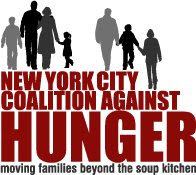 In honor of Hunger Action Month, government officials, hunger advocates and families across the country spent a week living on a food budget of $25 per person per week as part of a state- or locally-sponsored Food Stamp Challenge. How much does $25 a week buy? Not much, participants quickly realized.
In honor of Hunger Action Month, government officials, hunger advocates and families across the country spent a week living on a food budget of $25 per person per week as part of a state- or locally-sponsored Food Stamp Challenge. How much does $25 a week buy? Not much, participants quickly realized.
For families used to spending $200 a week on groceries, cutting their food budget in half to participate in the Challenge meant they had to buy different kinds of foods than they were used to eating. Many found that budgetary constraints forced them to choose filling foods rather than nutritious ones. "Our diet was a lot more starchy than it normally is and I think people have to eat a lot of starches and poor-quality proteins and probably not get enough fruits and vegetables," said Valerie Levanos, a Maryland mother of two taking part in the challenge. "I think it would be really hard to eat a healthy diet on food stamps. It would be impossible, I think."
When reporting on their week-long experience, government officials and bloggers noted their inability to fully modify their spending habits. After realizing that she no longer had access to food on the go, Illinois State Representative Kathy Ryg reported, “I could spend an entire $25 on Starbucks some weeks and [during the challenge] I didn't even buy coffee to make at home because I couldn't afford it.”
Said
Though the Food Stamp Challenge may be an exercise in empathy, the “challenge” for the 28 million Americans currently receiving food stamps will not end until the government allocates sufficient funding to the food stamp program and enacts living wage policies that will help families make enough money to sufficiently feed their families. Following the Food Stamp Challenge, participants’ memories of temporary hunger will mean little if the experience is not translated into advocacy for a living wage, job creation, and child nutrition programs like universal school breakfasts.
In the interim, USDA has released guidelines for families attempting to maintain a healthier diet on limited resources. Unfortunately, the USDA’s suggestions do not provide a way for people to gain access to fresh fruits and vegetables: The suggestions include looking for bargains on old bread and buying ultra-pasteurized milk to avoid spoiling.

No comments:
Post a Comment